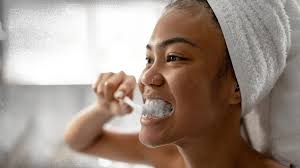As we learn about the chemical reaction, wondering if it is safe for the skin or not is obvious. Here, it is important to know that this Maillard reaction occurs every time you bring your skin near the flame, for instance, while cooking and roasting.
So, a self-tanner is somewhat similar to roasting the skin. Here’s what happens as a result of Maillard’s reaction-
1. Free Radicals Generate
As a response to Maillard’s reaction by self-tanners, free radicals are generated on the skin. Free radicals are the culprits behind premature aging as they degrade collagen and elastin fibers and cause wrinkles and fine lines.
This premature aging worsens if you step outside without sun protection, especially after applying self-tanner. More free radicals will start producing as UV rays will make DHA unstable.
2. Induces Skin Aging And Damages DNA
As DHA generates free radicals, skin experiences oxidative stress that works to accelerate skin aging. All this leads to blemishes, fine lines, wrinkles, uneven skin tone, and aging spots.
At the same time, studies have confirmed that DHA promotes cell death and also damages DNA. It has led people to question its long-term safety.
3. Reduces Vitamin D production
Studies have revealed that regular use of self-tanner can lower the body’s ability to produce Vitamin D. Melanoidin pigments created by the DHA inhibited the formation of vitamin D.
It could pose serious health issues as Vitamin D is an essential component needed to keep the bones, muscles, and teeth healthy.
4. Causes Skin Irritation
Regular use of self-tanner can cause skin irritation, especially among people with sensitive skin. It can cause severe dermatitis on certain skin types. Moreover, the presence of artificial fragrances in self-tanners to mask their typical odor can contribute to further skin reactions.
These are some of the major concerns regarding self-tanners. They are equally applicable to spray tanners as they also contain DHA as the active ingredient. Spray tanners, in fact, are more notorious as using them involves the risk of inhaling the mist that may enter the respiratory system and promote the chances of certain cancers.
So now that we know self-tanners can affect the skin in different ways, what are the alternatives?
The best alternative to self-tanners is using a DHA-free self-tanner.
DHA-free Self-tanner
DHA-free self-tanner is a safer option than chemical-based self-tanners. They are gentler on the skin and deliver a gradual glow.
You can find some companies offering organic or DHA-free self-tanners that comprise a purified keto-sugar that reacts with skin amino acids to produce a golden tone. The companies claim that their DHA-free self-tanners produce a golden bronze glow within two to three days without the sensory drawbacks and potential negative effects associated with DHA.
Apart from using DHA-free self-tanners, you can also go for DIY self-tanners that similarly stain and darken the skin tone.
Final Words
Even though tanning through a self-tanner is better than exposing skin to the sun, its side effects are also prominent.
The best way to keep skin safe is to get tanned occasionally and wear skin-nourishing lotions and creams to upkeep the skin’s health after every tanning session.




